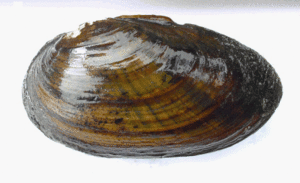Thick shelled river mussel facts for kids
The thick shelled river mussel (scientific name: Unio crassus) is a special type of freshwater mussel. It's an animal that lives in water and has two shells, like a clam. This mussel is a mollusk, part of the family called Unionidae, which are known as river mussels.
Quick facts for kids Thick shelled river mussel |
|
|---|---|
 |
|
| Unio crassus from Lužnice River, Czech Republic | |
| Conservation status | |
| Scientific classification | |
| Genus: |
Unio
|
| Species: |
crassus
|
How It Reproduces
Scientists have recently learned something cool about how this mussel reproduces. It crawls to the edge of the water. Then, it shoots out a stream of water from its body. This water often contains tiny baby mussels, called glochidia. Experts think this "spurting" helps spread the mussel babies to new places.
Why It's Disappearing
Sadly, the thick shelled river mussel has been disappearing across Europe for many years. This is happening because of several big problems:
- Dirty Water: The water in rivers and streams is not as clean as it used to be.
- Broken Homes: Their natural homes are being split up or destroyed. This is called habitat fragmentation.
- Missing Fish: These mussels need certain fish to help their babies grow. If there aren't enough of these fish, the mussels struggle to reproduce.
Where It Lives
The thick shelled river mussel naturally lives in Europe and parts of Western Asia. Here's a look at where it can be found and its situation in different countries:
- Croatia
- Czech Republic: It lives in Bohemia and Moravia. Here, it is considered endangered, meaning it's in danger of disappearing.
- Finland: Found in southern Finland, where it is vulnerable.
- France
- Germany: It's in critical danger of disappearing here. This mussel has vanished from 90% of the places it used to live in Germany.
- Netherlands: It is now locally extinct in the Netherlands. No living mussels have been seen there since 1968.
- Poland: It is endangered here.
- Slovakia: It is considered nearly threatened.
- Sweden: It is very rare.
- Denmark: People thought it had completely disappeared until it was found again in the Odense River in 2003. There are about 3,000 mussels in the Odense River. It was also found in the Suså River, but we don't know how many live there.


